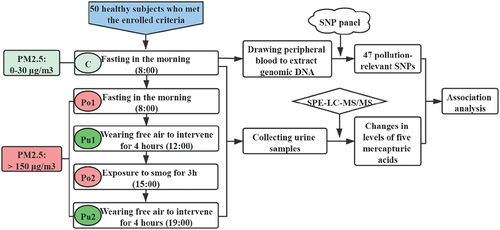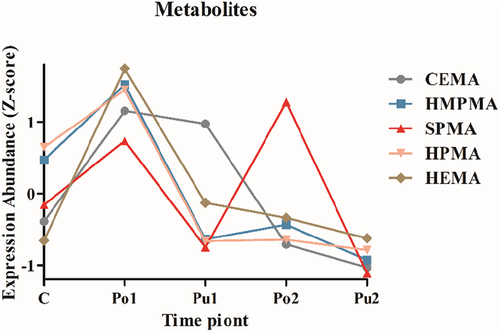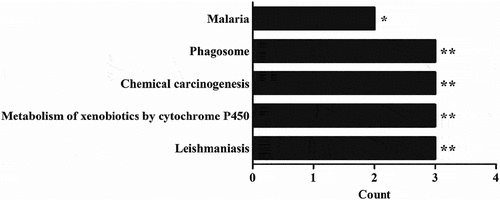Figures & data
Figure 1. Workflow of the research. a total of 50 healthy subjects were recruited according to the enrollment criteria. Peripheral blood and urinary samples of all participants were collected at five different time points, including Point C, Po1, Pu1, Po2 and Pu2. Then, SNP genotyping detection of genomic DNA from peripheral blood at Point C was conducted by an SNP panel, and the expression levels of five mercapturic acids in urinary samples at five points were detected by SPE-LC-MS/MS. Finally, association analysis between SNPs and changes in five mercapturic acids was carried out to discover potential biomarkers for the early monitoring of air pollution as risk factors for lung cancer. Point C: the clean time point; Point Po1: the first polluted time point; Point Pu1: the first purified time point; Point Po2: the second polluted time point; Point Pu2: the second purified time point.

Table 1. General characteristics of 50 healthy participants.
Table 2. Genotype of 47 pollution-relevant SNPs selected on the basis of their biological literature search.
Figure 2. Expression levels of five mercapturic acids in urinary samples at five different time points. Expression abundance represented the value after taking the average expression of mercapturic acids in 50 samples and normalizing by Z-score. CEMA: N-acetyl-S-(2-cyanoethyl)-cysteine; HMPMA: 3-hydroxy-1-methylpropylmercapturic acid; SPMA: N-acetyl-S-phenyl-L-cysteine; HPMA: N-acetyl-S-(3-hydroxypropyl)-l-cysteine; HEMA: N-acetyl-S-(2-hydroxyethyl)-L-cysteine.

Table 3. A total of 21 SNPs mapped to 9 genes had significant relationships with changes in expression levels of five mercapturic acids (P < .05).
Supplemental Material
Download MS Word (119.3 KB)Data availability statement
All the datasets in the current study are available from the corresponding author upon reasonable request.

